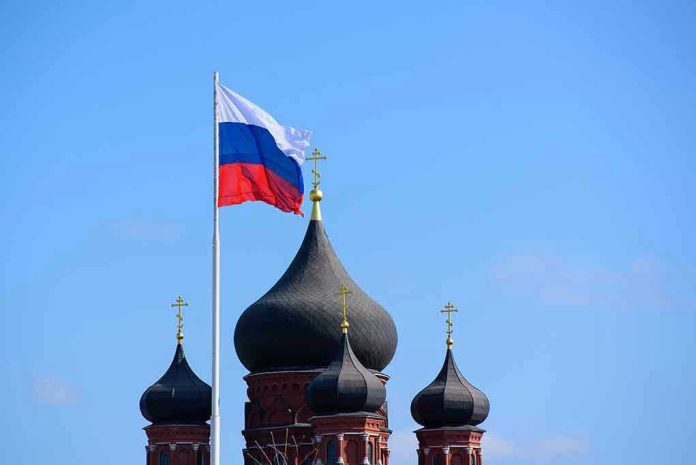
A new missile test by Russia threatens global stability, raising alarms about an escalating arms race.
Story Highlights
- Russia tests the 9M730 Burevestnik, a nuclear-powered cruise missile with “unlimited range.”
- Putin claims it can evade all current and future missile defenses.
- The missile’s development is a response to perceived Western threats and NATO expansion.
- Concerns rise over safety and environmental risks associated with the missile’s nuclear propulsion.
Russia’s New Missile Test Sparks Global Concerns
On October 21, 2025, Russian President Vladimir Putin announced the successful test flight of the 9M730 Burevestnik missile, also known by NATO as the SSC-X-9 Skyfall. The nuclear-powered cruise missile reportedly flew for 15 hours, covering 14,000 kilometers. Russian officials tout the missile’s “effectively unlimited range” and ability to evade current and future missile defenses. This development raises significant concerns in the West about the potential escalation of an arms race and the undermining of global stability.
Russia’s move is seen as a strategic counter to NATO’s missile defense systems and a demonstration of technological prowess amid ongoing tensions over Ukraine. The missile’s nuclear propulsion brings back memories of the abandoned U.S. Project Pluto due to similar safety and practicality concerns. The Burevestnik’s ability to unpredictably navigate missile defenses poses a new challenge to global security architectures, leading Western nations to reassess their defense postures and arms control strategies.
Historical Context and Development
The Burevestnik project was first unveiled by President Putin in March 2018, as part of a suite of new strategic weapons aimed at countering U.S. missile defense advancements and NATO expansion. This announcement followed the U.S. withdrawal from the 1972 Anti-Ballistic Missile Treaty in 2001, which Russia viewed as a strategic imbalance. The missile’s development has faced several challenges, including a fatal 2019 explosion at a Russian test site, reportedly linked to Burevestnik testing.
Despite these setbacks, the Russian government continues to push forward with the program, emphasizing its necessity in the face of perceived Western aggression. The Burevestnik is part of a broader effort by Russia to restore strategic balance and deter potential Western interventions. However, the risks associated with nuclear-powered weapons, including potential accidents and environmental hazards, remain a critical concern for the global community.
Implications and International Reactions
The successful test of the Burevestnik has significant implications for international security and arms control. In the short term, it has heightened tensions between Russia and the West, leading to increased focus on missile defense and arms control measures. In the long term, the missile could contribute to an arms race, undermining existing missile defense architectures and increasing proliferation risks.
PUTIN TESTS 'SKYFALL' NUKE MISSILE
'FLYING CHERNOBYL'26 October 2025, Sunday morning
Drudge Report pic.twitter.com/oU2V603s0d
— •fiesty•soter• (@MiniSoter) October 26, 2025
Western countries, particularly the United States and NATO, must now reassess their defense postures and arms control strategies to address this new threat. The global community faces increased nuclear risks and potential environmental hazards from the deployment of nuclear-powered weapons. As the international community grapples with these challenges, dialogue and diplomatic efforts are essential to prevent further escalation and ensure global stability.














